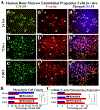Phenotypic characteristics of human bone marrow-derived endothelial progenitor cells in vitro support cell effectiveness for repair of the blood-spinal cord barrier in ALS
- PMID: 31493389
- PMCID: PMC6779528
- DOI: 10.1016/j.brainres.2019.146428
Phenotypic characteristics of human bone marrow-derived endothelial progenitor cells in vitro support cell effectiveness for repair of the blood-spinal cord barrier in ALS
Abstract
Amyotrophic lateral sclerosis (ALS) was recently recognized as a neurovascular disease. Accumulating evidence demonstrated blood-spinal-cord barrier (BSCB) impairment mainly via endothelial cell (EC) degeneration in ALS patients and animal models. BSCB repair may be a therapeutic approach for ALS. We showed benefits of human bone marrow endothelial progenitor cell (hBMEPC) transplantation into symptomatic ALS mice on barrier restoration; however, cellular mechanisms remain unclear. The study aimed to characterize hBMEPCs in vitro under normogenic conditions. hBMEPCs were cultured at different time points. Enzyme-linked immunosorbent assay (ELISA) was used to detect concentrations of angiogenic factors (VEGF-A, angiogenin-1, and endoglin) and angiogenic inhibitor endostatin in conditioned media. Double immunocytochemical staining for CD105, ZO-1, and occludin with F-actin was performed. Results showed predominantly gradual significant post-culture increases of VEGF-A and angiogenin-1 levels. Cultured cells displayed distinct rounded or elongated cellular morphologies and positively immunoexpressed for CD105, indicating EC phenotype. Cytoskeletal F-actin filaments were re-arranged according to cell morphologies. Immunopositive expressions for ZO-1 were detected near inner cell membrane and for occludin on cell membrane surface of adjacent hBMEPCs. Together, secretion of angiogenic factors by cultured cells provides evidence for a potential mechanism underlying endogenous EC repair in ALS through hBMEPC transplantation, leading to restored barrier integrity. Also, ZO-1 and occludin immunoexpressions, confirming hBMEPC interactions in vitro, may reflect post-transplant cell actions in vivo.
Keywords: Angiogenic factors; F-actin; Human bone marrow endothelial progenitor cells; In vitro; Tight junction proteins.
Copyright © 2019 Elsevier B.V. All rights reserved.
Conflict of interest statement
Conflict of Interest
The authors declare no conflict of interest.
Figures






Similar articles
-
Human Bone Marrow Endothelial Progenitor Cell Transplantation into Symptomatic ALS Mice Delays Disease Progression and Increases Motor Neuron Survival by Repairing Blood-Spinal Cord Barrier.Sci Rep. 2019 Mar 27;9(1):5280. doi: 10.1038/s41598-019-41747-4. Sci Rep. 2019. PMID: 30918315 Free PMC article.
-
Transplantation of human bone marrow stem cells into symptomatic ALS mice enhances structural and functional blood-spinal cord barrier repair.Exp Neurol. 2018 Dec;310:33-47. doi: 10.1016/j.expneurol.2018.08.012. Epub 2018 Aug 30. Exp Neurol. 2018. PMID: 30172620 Free PMC article.
-
Beneficial Effects of Transplanted Human Bone Marrow Endothelial Progenitors on Functional and Cellular Components of Blood-Spinal Cord Barrier in ALS Mice.eNeuro. 2021 Sep 16;8(5):ENEURO.0314-21.2021. doi: 10.1523/ENEURO.0314-21.2021. Print 2021 Sep-Oct. eNeuro. 2021. PMID: 34479980 Free PMC article.
-
Advancing Stem Cell Therapy for Repair of Damaged Lung Microvasculature in Amyotrophic Lateral Sclerosis.Cell Transplant. 2020 Jan-Dec;29:963689720913494. doi: 10.1177/0963689720913494. Cell Transplant. 2020. PMID: 32207340 Free PMC article. Review.
-
Amyotrophic lateral sclerosis: a neurovascular disease.Brain Res. 2011 Jun 29;1398:113-25. doi: 10.1016/j.brainres.2011.04.049. Epub 2011 May 12. Brain Res. 2011. PMID: 21632035 Review.
Cited by
-
Stem cell-derived extracellular vesicles as potential mechanism for repair of microvascular damage within and outside of the central nervous system in amyotrophic lateral sclerosis: perspective schema.Neural Regen Res. 2021 Apr;16(4):680-681. doi: 10.4103/1673-5374.294337. Neural Regen Res. 2021. PMID: 33063723 Free PMC article. No abstract available.
-
Cellular Components of the Blood-Brain Barrier and Their Involvement in Aging-Associated Cognitive Impairment.Aging Dis. 2024 Jul 1;16(3):1513-1534. doi: 10.14336/AD.202.0424. Aging Dis. 2024. PMID: 39122454 Free PMC article. Review.
-
Revealing the Proteome of Motor Cortex Derived Extracellular Vesicles Isolated from Amyotrophic Lateral Sclerosis Human Postmortem Tissues.Cells. 2020 Jul 16;9(7):1709. doi: 10.3390/cells9071709. Cells. 2020. PMID: 32708779 Free PMC article.
-
Patching Up the Permeability: The Role of Stem Cells in Lessening Neurovascular Damage in Amyotrophic Lateral Sclerosis.Stem Cells Transl Med. 2022 Dec 30;11(12):1196-1209. doi: 10.1093/stcltm/szac072. Stem Cells Transl Med. 2022. PMID: 36181767 Free PMC article. Review.
-
Detection of endothelial cell-associated human DNA reveals transplanted human bone marrow stem cell engraftment into CNS capillaries of ALS mice.Brain Res Bull. 2021 May;170:22-28. doi: 10.1016/j.brainresbull.2021.01.020. Epub 2021 Feb 2. Brain Res Bull. 2021. PMID: 33545308 Free PMC article.
References
Publication types
MeSH terms
Substances
Grants and funding
LinkOut - more resources
Full Text Sources
Miscellaneous

